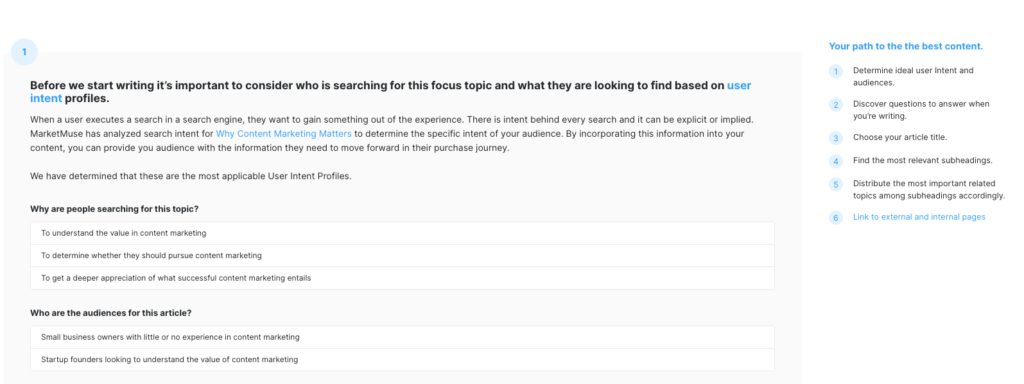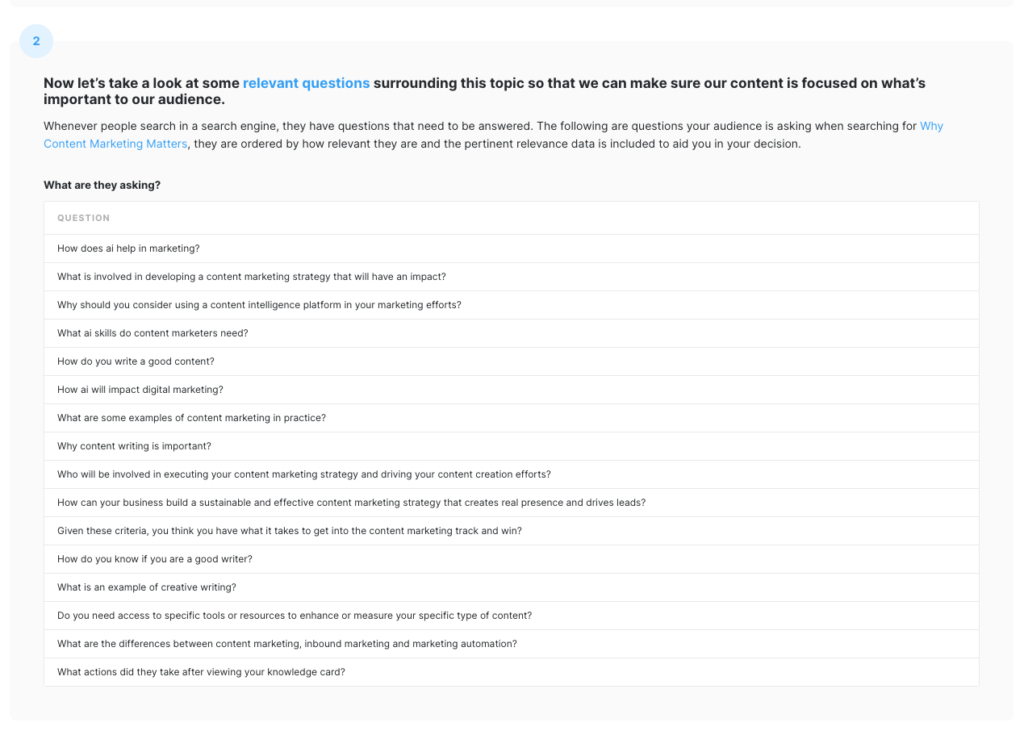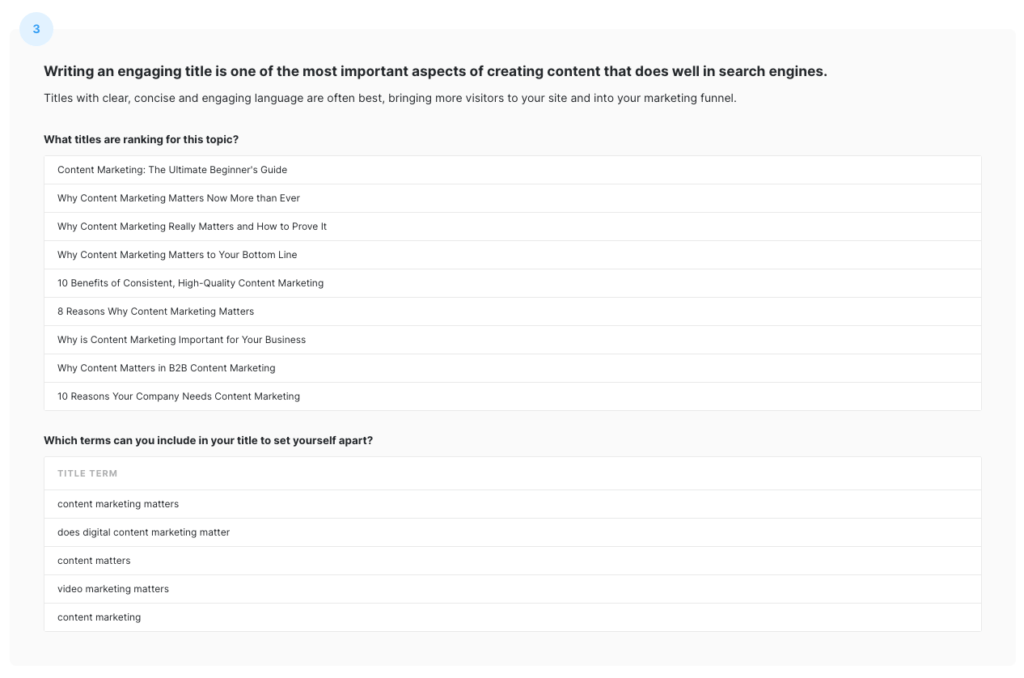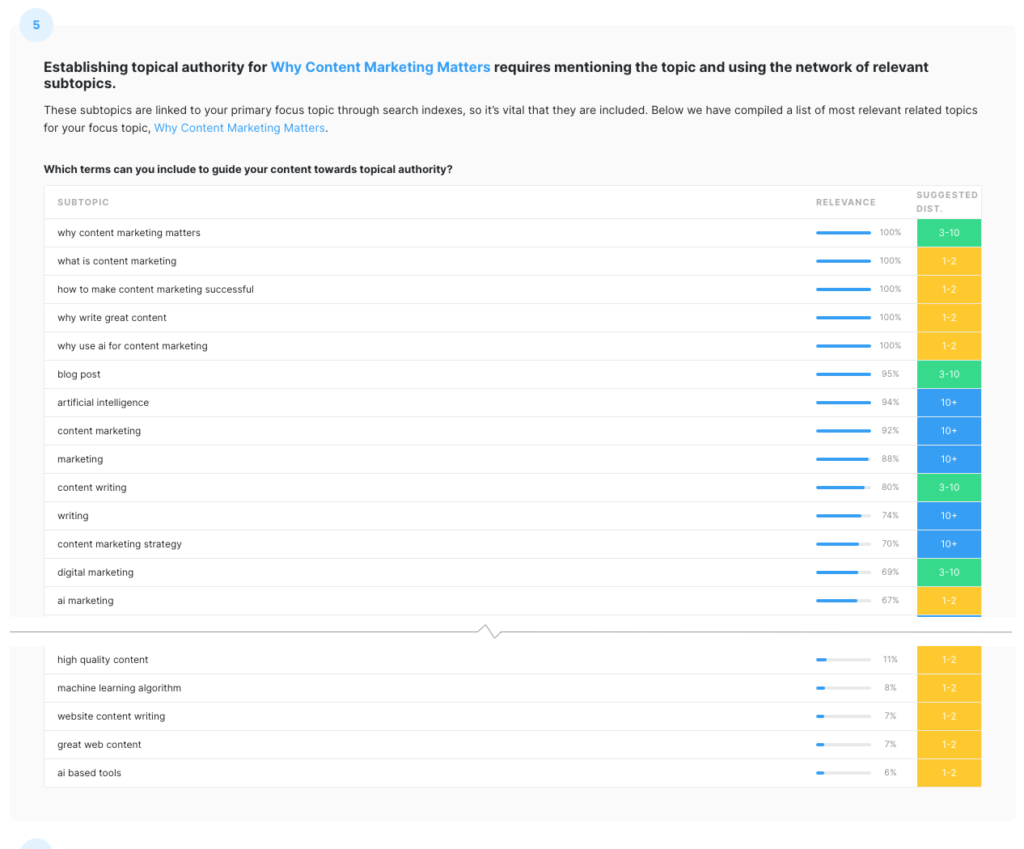What Is a MarketMuse Content Brief?
A content outline helps to ensure that a content strategy gets executed according to plan. It’s impossible to scale content production and maintain quality without this type of document.
Giving writers a keyword phrase and setting them loose is a haphazard process that typically results in disappointment. Alternately, meeting with writers at the beginning of their assignment is inefficient and prone to misinterpretation.
A content outline needs to document more than just the terms to include. MarketMuse content outlines, we call them Content Briefs, are very detailed, providing all the information necessary for anyone on a content team to consistently produce stellar content.

A MarketMuse Content Brief consists of two sections; the Executive Summary, and the Outline Brief. There are two types of content briefs:
- One for creating new content
- Another for updating an existing page
Both are very similar, but briefs for existing pages take into account the content that already occurs on the page.
Anyone can access a specific MarketMuse Content Brief through a shared link.
That link goes to a MarketMuse Brief for creating a new piece of content. We’ll be using it as an example for the remainder of this article. So feel free to open it up so you can follow along.

Anyone with a link can access a MarketMuse Content Brief and use the Optimize Application for that content. Good news if you work with multiple writers as no additional license is required.
Let’s look at a Content Brief for creating new content on the topic ‘how to write a blog post for SEO.’
Executive Summary
The executive summary is the first thing you’ll see when opening up any MarketMuse brief. As its name implies, the executive summary provides a marketing executive with the background necessary for why one should create this content and how. The summary opens with information about:
- The target score
- Suggested word count including a description of what these indicators mean
- The objective (either create new content or optimize an existing page)
The sections that following cover the steps required to create high-quality content, specifically:
- Determining ideal user intent and audiences
- Discovering questions to answer within your article
- Choosing an appropriate title
- Finding the most relevant subheading
- Distributing the most important and closely related topics among subtitles accordingly
- Linking to external and internal pages
Determine Ideal User Intent and Audiences.
This section explains who the audience is and why they are searching for this topic.

Discover Questions to Answer When You’re Writing
This section looks at some relevant questions surrounding this topic so you can make sure your content focuses on what’s valuable to your audience. We analyze all the competitive content on a given subject to determine the critical questions to answer in your article.

Choose Your Article Title
Creating an engaging title is an essential part of writing high-performing content. MarketMuse provides examples of titles that rank for the chosen. Additionally, there are topics and terms to include in your title that will set yours apart from the rest.

Find The Most Relevant Subheadings
Subheadings help guide the writing to better reflect topical authority that search engines use to rank web pages. Well-crafted subheadings make content easier to read and quicker to rank. MarketMuse Content Briefs provide an example of subheadings ranking well for the chosen topic plus terms to include in a title that differentiates it from the rest.

Terms That Can Guide Your Content Toward Topical Authority
Establishing authority on a specific subject requires more than a discussion on your chosen topic. You also need to touch upon issues that are closely related. MarketMuse provides a list of all the relevant subtopics pertaining to a chosen subject. The size of this list varies with the number of subheadings and target word count.

Link to External and Internal Pages
Linking helps search engines understand your topical authority. Internal links help create authoritative content clusters while external links benefit readers who expect to see them in trustworthy articles. This section provides suggested links and anchor text for the most appropriate internal web pages. These suggestions are also provided for external links, but these are for non-competitive sites.

Outline Brief
The outline brief is designed to help writers create better content faster. The outline provides a detailed article structure complete with subheadings, saving writers valuable time.

Target Content Score and Suggested Word Count
On the right side of the brief is a Target Content Score and suggested word count. Each section also has a recommended word count displayed as a percentage of the total word count. This figure gives writers an idea of how much space to devote to a subsection without getting side-tracked in meeting a specific word count target.
Ranking Titles, Title Terms, and Subheading Terms
These sections are optional and only appear if one or more items are selected for display during content brief editing. Ranking Titles are examples of titles that were ranking at the time the content brief was created. Title Terms are suggestions for inclusion within the title.
User Audience and User Intents
These optional sections indicate the audience for which the article is intended and why this audience is searching.

Subtopics
This list shows which subtopics to mention, some of which can be included in the article’s introduction. ‘Suggested Dist.’ refers to the number of times to mention a topic without it appearing awkward and unnatural.

Sections
A MarketMuse Content Brief contains several sections. Each one follows the same format:
- Suggested subheading
- Suggested word count for that section (expressed as a percentage of the total word count)
- Questions to answer
- Topics to mention including their suggested distribution
- Internal link with anchor text (the anchor text is a highly relevant topic, while the suggested link is a page that’s a good match for that topic)
- External link (the anchor text is a topic with lower relevance with a suggested link of high authority and quality)

Note that each section has its own set of related topics. If we were to combine the topic list from each section, we would see that the resulting catalog is very extensive.
External links are chosen based on anchor text with low topical relevance for a particular reason. We want to link to a high-quality, authoritative source that’s not in direct competition with the topic our article targets. We achieve these criteria by choosing topics that are adjacent to the central theme, thus providing value to both the audience and search engines while helping to achieve the goals of the article as well.
The Value of a Content Brief
Writers need more than just a list of keywords to include in their articles. Detailed content briefs reduce the potential for miscommunication and ensure all the necessary elements for a high-performing are covered.
Stephen leads the content strategy blog for MarketMuse, an AI-powered Content Intelligence and Strategy Platform. You can connect with him on social or his personal blog.